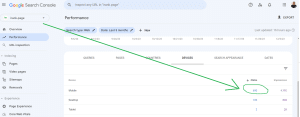In today’s digital age, Google has become the go-to platform for people searching for services and businesses. But have you ever wondered how people actually search for services in Google? Understanding user behavior and optimizing your website for these search patterns can greatly enhance your online visibility and attract potential customers. In this blog post, we will explore the common search patterns used by people when looking for services on Google and discuss the importance of on-page SEO in making your website more visible to these search queries.
How People Search for Services in Google: When it comes to searching for services in Google, people typically follow two main search patterns. The first pattern involves typing the desired service followed by the location, while the second pattern reverses the order, with the location being typed first. Let’s delve deeper into each of these patterns:
- Services + Location: Many users will start their search by typing the specific service they are looking for, followed by the location. For example, someone in need of plumbing services in Los Angeles might search for “plumbing services Los Angeles” or “Los Angeles plumbing services.” This search pattern allows users to find service providers that are geographically relevant to their needs. As a business owner, optimizing your website for these service + location keywords is crucial to appear in the search results when potential customers are actively seeking your services in their area.
- Location + Services: Alternatively, some users will begin their search by typing the location first, followed by the desired service. For instance, someone in San Francisco looking for a web design agency might search for “San Francisco web design” or “web design in San Francisco.” This search pattern allows users to find service providers specifically located in their desired area. As a business owner, it is important to optimize your website for location + service keywords to increase your chances of appearing in the search results for users in that specific location.
The Importance of On-Page SEO for Visibility: To ensure that your website is visible to users searching for services in Google, implementing effective on-page SEO strategies is essential. On-page SEO refers to optimizing various elements within your website to improve its search engine rankings. Here are some key on-page SEO practices to consider:
- Keyword Optimization: Conduct thorough keyword research to identify relevant keywords related to your services and target locations. Incorporate these keywords strategically within your website’s content, titles, headings, meta tags, and URLs to signal to search engines that your website is relevant to those search queries.
- High-Quality Content: Create informative, engaging, and valuable content that addresses the needs and questions of your target audience. Develop content that showcases your expertise in your industry and provides solutions to common problems. Remember to include relevant keywords naturally within your content to enhance its visibility in search results.
- Page Speed and Mobile Optimization: Ensure that your website loads quickly and is mobile-friendly. Page speed and mobile optimization are important ranking factors that can significantly impact user experience. A slow-loading website or a website that is not mobile-responsive may deter users and negatively affect your search engine rankings.
- User-Friendly Navigation: Design your website with a clear and intuitive navigation structure that allows users to easily find the information they are looking for. A user-friendly website not only enhances the overall user experience but also helps search engines crawl and index your pages more efficiently.
- Metadata Optimization: Optimize your meta titles and meta descriptions for each page of your website. These elements appear in the search results and provide a brief summary of what users can expect from your page. Including relevant keywords and compelling descriptions can entice users to click on your website in the search results.
In Conclusion: Understanding how people search for services in Google and implementing effective on-page SEO strategies are key to
increasing your visibility and attracting potential customers. By recognizing the common search patterns of users, such as service + location and location + service, you can optimize your website’s content and structure to align with these search queries.
However, on-page SEO goes beyond just keyword optimization. It involves creating high-quality content, optimizing page speed and mobile responsiveness, ensuring user-friendly navigation, and optimizing metadata. These practices collectively contribute to improving your website’s visibility and search engine rankings.
Remember that SEO is an ongoing process. Regularly monitoring your website’s performance, conducting keyword research, and adapting your strategies based on changes in user behavior and search engine algorithms are crucial for maintaining and improving your visibility in search results.
At [Your Business Name], we understand the importance of effective SEO and its impact on your online presence. Our team of experts specializes in providing comprehensive SEO solutions, including keyword research, on-page optimization, content creation, and website auditing. We work closely with you to develop a customized strategy that aligns with your business goals and helps you outrank your competitors.
Boost your visibility and attract more customers by optimizing your website for the way people search for services in Google. Contact us at [Your Phone Number] or visit our website [Your Website URL] to learn more about our SEO services and how we can help you achieve higher rankings and increased online visibility.
Remember, understanding how people search and implementing effective on-page SEO strategies are key to reaching your target audience and driving more organic traffic to your website. Stay ahead of the competition by staying informed about the latest SEO trends and continuously refining your strategies to meet the ever-evolving demands of search engine algorithms.







